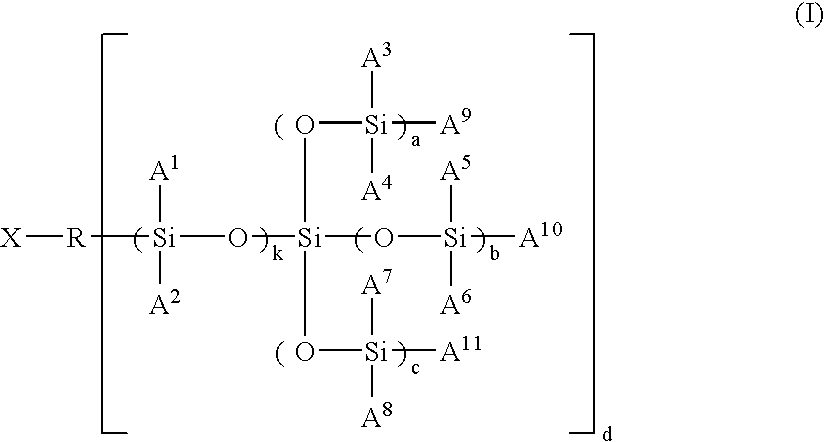Method for producing polymers for ophthalmic lens and ophthalmic lens
- Summary
- Abstract
- Description
- Claims
- Application Information
AI Technical Summary
Problems solved by technology
Method used
Image
Examples
example 1
[0074] The organosiloxane group-containing monomer (30 parts by weight) obtained in Synthesis 1, tris(trimethylsiloxy)silylpropyl methacrylate (30 parts by weight), N,N-dimethyl acrylamide (40 parts by weight), polyethylene glycol dimethacrylate ("Blenmer" PDE600, manufactured by NOF CORPORATION; 1 part by weight) and diethylene glycol dimethyl ether (20 parts by weight) were mixed uniformly and "Darocure" 1173 (manufactured by CIBA Specialty Chemicals Inc.; 0.5 part by weight) was added as a polymerization initiator, after which this monomer mixture was deaerated in an argon atmosphere. It was then poured into a contact lens mold made of a transparent resin (poly 4-methylpentene-1) in a glove box in a nitrogen atmosphere, polymerization was performed by photo-irradiation (1 mW / cm.sup.2, 30 minutes) using an inset attraction lamp, and a lens-shaped sample was obtained.
[0075] The lens-shaped sample that was obtained was immersed in the solution that was obtained in Synthesis 4, and t...
example 2
[0076] The organosiloxane group-containing monomer (40 parts by weight) obtained in Synthesis 1, tris(trimethylsiloxy)silylpropyl methacrylate (20 parts by weight), N,N-dimethyl acrylamide (20 parts by weight), polyethylene glycol dimethacrylate ("Blenmer" PDE600, manufactured by NOF CORPORATION; 1 part by weight) and diethylene glycol dimethyl ether (20 parts by weight) were mixed uniformly, and a lens-shaped sample was obtained in the same way as in Example 1.
[0077] The lens-shaped sample that was obtained was immersed in a mixed solution of 20 g of triethylamine, 0.4 g of succinic anhydride and 0.16 g of pyridine, and the materials were stirred slowly for 9 hours at room temperature. After the reaction was completed, successive solution replacement was performed in the same way as in Example 1 and a hydrogel lens was obtained. It was subjected similarly to boiling treatment for 30 minutes at 121.degree. C. The table below shows the physical properties of the sample that was obtai...
example 3
[0078] The organosiloxane group-containing monomer (10 parts by weight) obtained in Synthesis 2, tris(trimethylsiloxy)silylpropyl methacrylate (55 parts by weight), N,N-dimethyl acrylamide (35 parts by weight), triethylene glycol dimethacrylate (0.5 part by weight) and diethylene glycol dimethyl ether (20 parts by weight) were mixed uniformly, and a lens-shaped sample was obtained in the same way as in Example 1.
[0079] The lens-shaped sample that was obtained was immersed in a mixed solution of 20 g of polyethylene glycol monoallyl ether of a molecular weight of approximately 1500, 80 g of diethylene glycol dimethyl ether that had been dehydrated with molecular sieve and 0.02 g of chloroplatinic acid, and a reaction was carried out for 9 hours at 60.degree. C. After the reaction was completed, solutions were replaced successively in the same way as in Example 1 and a hydrogel lens was obtained. It was subjected similarly to boiling treatment for 30 minutes at 121.degree. C. The tabl...
PUM
| Property | Measurement | Unit |
|---|---|---|
| Fraction | aaaaa | aaaaa |
| Fraction | aaaaa | aaaaa |
| Fraction | aaaaa | aaaaa |
Abstract
Description
Claims
Application Information
 Login to View More
Login to View More - R&D
- Intellectual Property
- Life Sciences
- Materials
- Tech Scout
- Unparalleled Data Quality
- Higher Quality Content
- 60% Fewer Hallucinations
Browse by: Latest US Patents, China's latest patents, Technical Efficacy Thesaurus, Application Domain, Technology Topic, Popular Technical Reports.
© 2025 PatSnap. All rights reserved.Legal|Privacy policy|Modern Slavery Act Transparency Statement|Sitemap|About US| Contact US: help@patsnap.com



